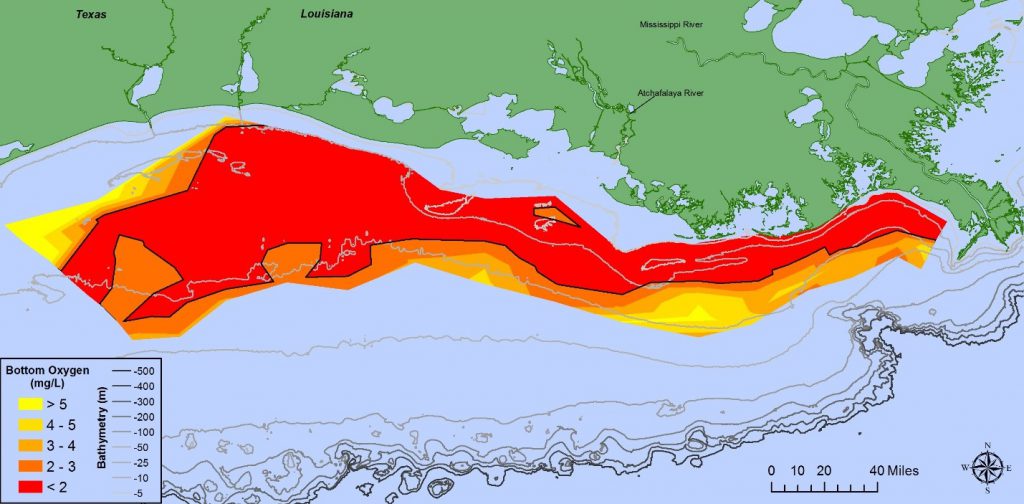This historical program remains on this website to highlight projects it funded, which all closed by August 31, 2022.
Northern Gulf of Mexico Ecosystems & Hypoxia Assessment (NGOMEX)
Background
The northern portion of the Gulf of Mexico ecosystem, a region containing almost half of the nation’s coastal wetlands and supporting commercial fisheries generating $1 billion annually, has undergone profound changes due to nutrient enrichment of Mississippi River water from land-based sources. This over-enrichment of nutrients stimulates the development of seasonal hypoxia (very low oxygen waters) over the Louisiana/Texas continental shelf during the summer and results in the largest recurring hypoxic zone (or “Dead Zone”) in the United States. Hypoxic waters can cause habitat loss, stress and even death to marine organisms, affecting commercial harvests and the health of impacted ecosystems. While the dead zone size can vary substantially from year to year, the 5-year average is remains larger than the Mississippi River/Gulf of America Hypoxia Task Force (HTF) reduction goal of 5,000 square kilometers.

Program Highlights
Building on program research starting in 2000, the NGOMEX program addresses the hypoxic zone in the Gulf through the funding of multi-year, interdisciplinary research projects. As part of these efforts, NGOMEX has heavily supported monitoring activities in the Gulf including the annual July shelfwide monitoring cruise which provides the data used by the HTF to monitor changes in the dead zone over time. Current studies are documenting the dynamics of the hypoxic zone over the Louisiana continental shelf and helping to better define the biological, chemical, and physical processes that influence hypoxic zone development and determine its extent, and impacts on fisheries.
Links to current projects (2016-2020) include:
- Synthesis and Integrated Modeling of Long-term Data Sets to Support Fisheries and Hypoxia Management in the Northern Gulf
- Using Linked Models to Predict the Impacts of Hypoxia on Gulf Coast Fisheries under Scenarios of Watershed and River Management
- User-driven tools to predict and assess effects of reduced nutrients and hypoxia on living resources in the Gulf
Related Links
- View All NGOMEX Content (Search NGOMEX)
- Hypoxia Task Force Action Plan 2008
- Hypoxia in the Northern Gulf of America: An Update by the EPA Science Advisory Board (2007)
- Committee on Environment and Natural Resources (CENR) National Centers for Coastal Ocean Science Gulf of Mexico Hypoxia Assessment (1999)
- LUMCON: Hypoxia in the Northern Gulf
- Nutrient Enhanced Coastal Ocean Productivity (NECOP) Program
- A Science Strategy To Support Management Decisions Related To Hypoxia In The Northern Gulf Of Mexico And Excess Nutrients In The Mississippi River Basin (2004)
- Gulf of America Hypoxia Watch
- Nutrient Loading for the Mississippi River and Subbasins (new)
- Harmful Algal Bloom and Hypoxia Research and Control Act (HABHRCA)
- Mississippi River/Gulf of America Hypoxia Task Force
